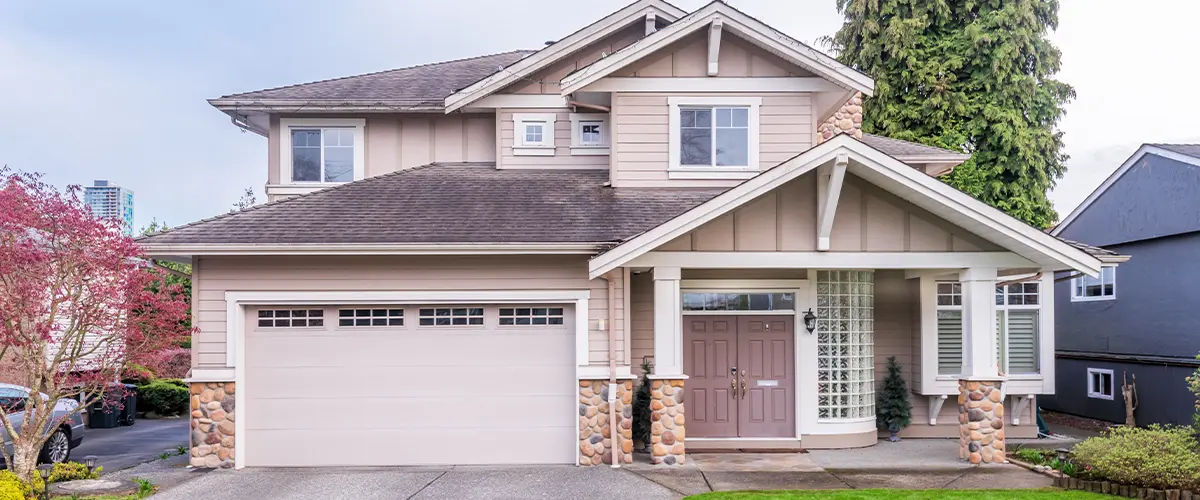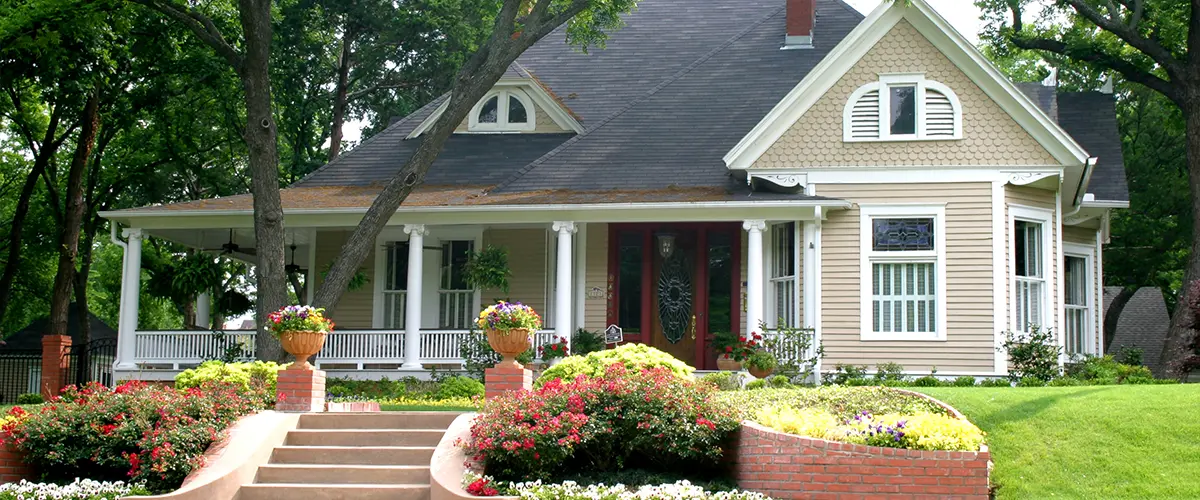Discover the Differences Between Modern Vs Traditional House
Navigating the crossroads between tradition and innovation in home design can profoundly influence the rhythm of your daily life.
At Conklin Construction, we’re dedicated to illuminating the path that leads to your perfect home, whether it’s steeped in the rich legacy of traditional architecture or sculpted with the sleek contours of modern innovation.
This exploration into modern versus traditional homes is more than a comparison—it’s a journey towards discovering a living space that resonates with your personal style, functional needs, and aesthetic aspirations.
Keep reading for insights!

Overview of Modern vs Traditional House
Traditional Architecture Style
Homes built in the traditional architecture style often reflect a rich history and timeless beauty. They incorporate features from the past, using materials like brick, wood, and stone to create structures that stand the test of time.
Classic designs include gabled roofs, arched doorways, and symmetrical windows. These elements combine to give traditional homes their distinct and enduring appeal.
Inside a traditional house, you’ll find layouts that favor function over open spaces. Rooms are clearly defined with walls and doors separating living areas from dining rooms and kitchens.
This design supports privacy while fostering cozy environments for families to gather.
Craftsmanship shines through detailed woodworking, decorative moldings, and intricate tile work – hallmark qualities of traditional style that celebrate skilled labor and artistry.

Modern Architecture Style
Modern architecture embraces simplicity and clean lines. Architects focus on creating spaces that merge with their surroundings, using glass, steel, and concrete as primary materials.
This approach allows for open floor plans and large windows that flood interiors with natural light, making modern houses feel more spacious and connected to the outdoors.
The emphasis on horizontal and vertical lines in design adds a sense of order and harmony to these homes.
Every detail in modern design serves a purpose, avoiding unnecessary decoration. Furniture often features sleek, minimalist designs that complement the overall aesthetic of the space.
Colors are typically neutral or monochromatic, which helps create a calm and cohesive environment.
Modern architecture not only prioritizes aesthetics but also functionality and sustainability, incorporating energy-efficient systems and eco-friendly materials whenever possible to reduce environmental impact while enhancing living conditions.

Key Differences Between Traditional and Modern Homes
Traditional homes typically feature intricate architectural details and ornate designs, while modern homes focus on sleek, clean lines and minimalistic aesthetics.
The floor plan in traditional homes often includes separate rooms for specific functions, whereas modern homes tend to have open-concept layouts that promote a sense of spaciousness.
- Floor Plan
Traditional homes typically feature intricate architectural details and ornate designs, while modern homes focus on sleek, clean lines and minimalistic aesthetics.
The floor plan in traditional homes often includes separate rooms for specific functions, whereas modern homes tend to have open-concept layouts that promote a sense of spaciousness.
- Natural Light
Large windows and open floor plans in modern homes maximize natural light, creating a bright and airy atmosphere. This design feature not only contributes to energy efficiency but also enhances the overall ambiance of the living spaces.
Additionally, ample sunlight can positively impact mood, productivity, and health within the home environment.
- Furniture
Modern homes often feature sleek, minimalist furniture that complements the clean lines and open spaces of their design. The focus is on functionality and simplicity, with an emphasis on neutral colors and materials like metal, glass, and leather.
In contrast, traditional homes tend to showcase more ornate and decorative furniture pieces that reflect a timeless elegance. Wood is a prominent material in traditional furniture, often featuring intricate carvings and attention to detail.
The choice of furniture can significantly impact the overall aesthetic of a home – whether it’s the modern appeal of clean lines or the timeless charm exuded by classic designs.
Additionally, the carefully selected pieces can tie together the entire interior design concept.
- Finishes
Modern homes often feature sleek and minimalistic finishes, emphasizing clean lines and simplicity.
These finishes typically include materials like glass, concrete, metal, and wood in neutral or monochromatic color palettes, creating a contemporary look that exudes sophistication.
In contrast, traditional homes tend to incorporate warmer finishes such as brick, stone, and timber to evoke a sense of timelessness and comfort. The use of ornate moldings and intricate detailing is also common in traditional home finishes.
- Kitchen Layout
The kitchen layout is a vital element in both traditional and modern homes. In modern homes, the kitchen is often designed with an open floor plan to create a seamless flow between the cooking, dining, and living areas.
This design emphasizes functionality and social interaction as it allows for easier navigation within the space.
In contrast, traditional homes usually have a more compartmentalized kitchen layout with distinct boundaries between the cooking area and other living spaces.
In terms of finishes, modern kitchens tend to feature sleek surfaces and minimalistic cabinetry for a clean aesthetic appeal while traditional kitchens may showcase ornate details and warmer color palettes in their design.

Reasons to Choose a Modern Home
For those seeking a home designed to enhance functionality and energy efficiency, modern homes offer a minimalistic design with an aesthetic appeal.
They provide sustainable living in addition to catering for the ever-evolving needs of contemporary living.
- Minimalistic Design
Minimalistic design is characterized by simplicity, clean lines, and a focus on functionality. It emphasizes open spaces, neutral colors, and uncluttered environments.
This design style often incorporates sleek furniture and minimalist decor to create a sense of calm and tranquility in the home.
By eliminating unnecessary elements and embracing a less-is-more approach, minimalistic design can bring a sense of clarity and order to living spaces while promoting a modern aesthetic.
Choosing a modern home with minimalistic design can provide a serene living environment that promotes relaxation and mindfulness.
The streamlined look of minimalism also contributes to an overall feeling of spaciousness within the home, making it an attractive option for those seeking an uncluttered lifestyle.
- Aesthetic Appeal
Modern homes are known for their clean lines, open spaces, and minimalistic design. This style often emphasizes the use of natural light and simple color palettes to create a sense of airiness and tranquility throughout the space.
Modern homes also focus on incorporating sleek furniture and finishes that exude a contemporary vibe.
In addition, modern kitchen layouts prioritize functionality and efficiency, with an emphasis on integrating cutting-edge appliances into the overall aesthetic.
The aesthetic appeal of modern homes lies in their ability to seamlessly blend form and function. The minimalist approach creates an uncluttered atmosphere that promotes calmness and simplicity within the living space.
- Functionality
Modern homes are designed to enhance functionality, offering open floor plans that allow for versatile use of space. Additionally, modern homes often prioritize efficient storage solutions and integrated technology to streamline daily living.
The kitchen layout in modern homes is tailored towards ease of use and practicality, with a focus on maximizing convenience while cooking and entertaining.
Energy-efficient appliances and sustainable materials further underpin the functionality of modern homes, making them ideal for those seeking more than just a dwelling place.
Moving forward to “Energy Efficiency” as we delve into the eco-conscious aspects of modern home design.
- Energy Efficiency
Modern homes are designed with energy efficiency in mind. They utilize advanced insulation materials and techniques to optimize heating and cooling, reducing energy consumption.
Energy-efficient windows and doors help to minimize heat loss during colder months, while also preventing excessive heat gain in warmer seasons.
In addition, modern appliances and lighting fixtures are designed to conserve energy and reduce overall utility costs.
Furthermore, many modern homes integrate renewable energy sources such as solar panels or wind turbines, contributing to a sustainable living environment.
These features not only benefit the environment but also result in significant cost savings for homeowners over time.
- Sustainable Living
Modern homes are designed to enhance sustainable living. They incorporate energy-efficient appliances, sustainable materials, and smart home technology to reduce environmental impact.
Furthermore, modern homes often feature eco-friendly elements such as solar panels, rainwater harvesting systems, and green roofs that contribute to a more sustainable lifestyle.
These features not only benefit the environment but also lead to cost savings for homeowners in the long run.
In addition to their aesthetic appeal and functionality, modern homes are built with sustainability in mind.
By integrating eco-friendly practices and technologies into the design, modern houses offer an environmentally conscious way of living while promoting a greener future for generations to come.

Your Dream Home Awaits: Making the Choice with Conklin Construction
When choosing between traditional and modern homes, consider the differences in floor plan layout, natural light utilization, furniture style, finishes, and kitchen design.
Modern homes offer a minimalistic design, aesthetic appeal, functionality, energy efficiency and sustainable living features.
These factors make modern homes a popular choice for those seeking contemporary architecture with sleek lines and innovative design elements.
FAQs
Transform Your Dream into Reality with Conklin Construction
Are you ready to take the first step towards creating a home that perfectly aligns with your vision?
Whether you lean towards the elegant charm of traditional designs or the sleek sophistication of modern architecture, our team at Conklin Construction is here to bring your vision to life.
Contact us today to begin crafting a home that’s not just a place to live, but a reflection of your personal journey and aspirations. (608) 839-0620
